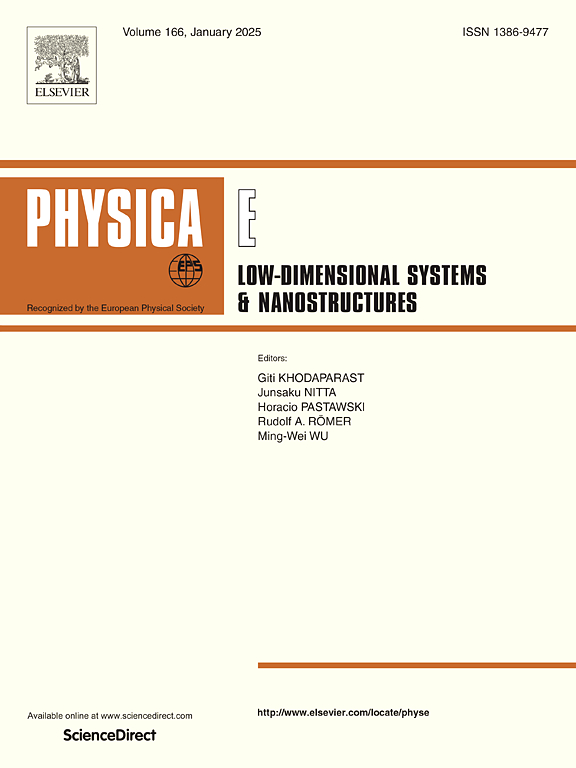Thermal behavior of two-nanowire-qubits states: Local quantum Fisher information and local quantum uncertainty
IF 2.9
3区 物理与天体物理
Q3 NANOSCIENCE & NANOTECHNOLOGY
Physica E-low-dimensional Systems & Nanostructures
Pub Date : 2025-06-29
DOI:10.1016/j.physe.2025.116317
引用次数: 0
Abstract
This study investigates the generation and robustness of thermal nanowire quantum correlations (NWQCs) within a 2D electron gas system in an InAs quantum nanowire. The system is with a parabolic harmonic confinement potential, a perpendicular magnetic field, Rashba spin–orbit (RSO) coupling, and an external electric field. Using local quantum Fisher information (LQFI), local quantum uncertainty (LQU), and logarithmic negativity, the thermal quantum correlations are studied to account for Rashba spin–orbit coupling and magnetic field effects in both the absence and presence of external electric fields. It is found that enhancing thermal nanowire quantum correlations (NWQCs) can be achieved by reducing Rashba spin–orbit coupling and the strengths of external magnetic and electric fields. In our study, we investigate how Rashba spin–orbit coupling and external magnetic and electric fields affect the thermal nanowire quantum correlations generated at a given bath temperature. Furthermore, decreasing the couplings of the RSO interaction, magnetic field, or electric field reduces the thermal NWQCs’ dependence on each of these factors. The results show that the intensity of the external magnetic field and Rashba spin–orbit interaction control the symmetric dependence of thermal nanowire quantum correlations on the electric field coupling.
双纳米线量子比特态的热行为:局部量子Fisher信息和局部量子不确定性
本研究研究了InAs量子纳米线中二维电子气体系统中热纳米线量子相关(nwqc)的产生和鲁棒性。该系统具有抛物型谐波约束势、垂直磁场、Rashba自旋轨道耦合和外电场。利用局域量子费雪信息(LQFI)、局域量子不确定性(LQU)和对数负性,研究了在外电场存在和不存在情况下Rashba自旋轨道耦合和磁场效应的热量子相关。研究发现,通过减小Rashba自旋-轨道耦合以及外加磁场和电场的强度,可以增强纳米线的热量子相关性。在我们的研究中,我们研究了Rashba自旋轨道耦合和外部磁场和电场如何影响在给定浴温下产生的热纳米线量子相关性。此外,减少RSO相互作用、磁场或电场的耦合可以减少热nwqc对这些因素的依赖。结果表明,外磁场强度和Rashba自旋轨道相互作用控制了热纳米线量子相关对电场耦合的对称依赖。
本文章由计算机程序翻译,如有差异,请以英文原文为准。
求助全文
约1分钟内获得全文
求助全文
来源期刊
CiteScore
7.30
自引率
6.10%
发文量
356
审稿时长
65 days
期刊介绍:
Physica E: Low-dimensional systems and nanostructures contains papers and invited review articles on the fundamental and applied aspects of physics in low-dimensional electron systems, in semiconductor heterostructures, oxide interfaces, quantum wells and superlattices, quantum wires and dots, novel quantum states of matter such as topological insulators, and Weyl semimetals.
Both theoretical and experimental contributions are invited. Topics suitable for publication in this journal include spin related phenomena, optical and transport properties, many-body effects, integer and fractional quantum Hall effects, quantum spin Hall effect, single electron effects and devices, Majorana fermions, and other novel phenomena.
Keywords:
• topological insulators/superconductors, majorana fermions, Wyel semimetals;
• quantum and neuromorphic computing/quantum information physics and devices based on low dimensional systems;
• layered superconductivity, low dimensional systems with superconducting proximity effect;
• 2D materials such as transition metal dichalcogenides;
• oxide heterostructures including ZnO, SrTiO3 etc;
• carbon nanostructures (graphene, carbon nanotubes, diamond NV center, etc.)
• quantum wells and superlattices;
• quantum Hall effect, quantum spin Hall effect, quantum anomalous Hall effect;
• optical- and phonons-related phenomena;
• magnetic-semiconductor structures;
• charge/spin-, magnon-, skyrmion-, Cooper pair- and majorana fermion- transport and tunneling;
• ultra-fast nonlinear optical phenomena;
• novel devices and applications (such as high performance sensor, solar cell, etc);
• novel growth and fabrication techniques for nanostructures

 求助内容:
求助内容: 应助结果提醒方式:
应助结果提醒方式:


